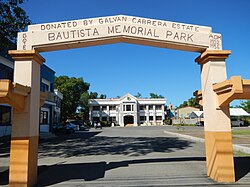Bautista, Pangasinan
| Bautista | ||
|---|---|---|
| Municipality | ||
 |
||
|
||
 Map of Pangasinan showing the location of Bautista |
||
| Location within the Philippines | ||
| Coordinates: 15°47′N 120°30′E / 15.783°N 120.500°ECoordinates: 15°47′N 120°30′E / 15.783°N 120.500°E | ||
| Country |
|
|
| Region | Ilocos (Region I) | |
| Province | Pangasinan | |
| District | 5th District, Pangasinan | |
| Founded | May 5, 1900 | |
| Barangays | 18 | |
| Government | ||
| • Mayor | Amadeo Totaan Espino | |
| • Vice Mayor | Joseph Guinto Espino | |
| • Electorate | 17,974 voters (2016 election) | |
| Area | ||
| • Total | 46.33 km2 (17.89 sq mi) | |
| Population (2015 census) | ||
| • Total | 32,307 | |
| • Density | 700/km2 (1,800/sq mi) | |
| Time zone | PST (UTC+8) | |
| ZIP code | 2424 | |
| 015510000 | ||
| IDD : area code | +63 (0)75 | |
| Income class | 4th municipal income class | |
| Revenue | ₱ 7,360,753.67 (2016) | |
| Poverty incidence | 10.01 (2012) | |
Bautista is a 4th class municipality in the province of Pangasinan, Philippines. According to the 2015 census, it has a population of 32,307 people.
Bautista is called the "The Walis Tambo (broom) Capital of Pangasinan". It is honored as the "Lupang Hinirang".
Bautista is located east of Pangasinan part of the Pangasinan's Fifth Congressional District with a land area of 8,213 hectares and 32 kilometers off Dagupan. Bautista is bounded by Alcala, Pangasinan, north; Bayambang, south, Agno River and Moncada, Tarlac, east.
Bautista is politically subdivided into 19 barangays:
Barangay Poblacion West is the site where the lyrics of the Philippine National Anthem were written, and it is known as the "Home of the Philippine National Anthem". In 1899, Jose Palma wrote his poem "Filipinas" which became the Anthem's lyrics.
Boletin Ecclesiastico de Filipinas published that the Dominicans founded Pangasinan towns of Binalatongan (City of San Carlos, 1588), Calasiao, 1588, Mangaldan, 1600, Manaoag, 1608, Lingayen, 1614, Dagupan, 1614 and Telbang (now Bautista, 1614). A historian, Rosario Cortez, however, wrote that Bautista existed since 1686, but was removed to the Parish of Bayambang.
The "Rebirth of Bautista" as municipality was only in 1900. Don Ramon Reynado became the first town executive along with other notable founder: Guillermo Agcaoile, Francisco Gonzales, Felipe Ramos, Dionisio Galvan, Teodoro Carungay, Claudio and Antonio Galsim, Marciano Guzman, Nicolas Galsim, Marcelino Villanueva and Eleno Cayabyab.
Bautista was dubbed "mercancia" or "Melting Pot" (where cargoes due to Camiling, Tarlac were traded via the Agno River or by train). The municipality was truly a melting pot, indicative of which is the diversity of people's dialects and languages. The residents of the town were Pangasinenses, Ilocanos, Tagalogs, Pampangos, Chinese and Spanish. The people of Nibaliw, Baluyot and Cabuaan are mostly Pangasinenses. The people of Nandacan, Villanueva, Poponto, Primicias, Artacho and Pogo are predominantly Ilocanos. Within the Poblacion, one would be able to meet a number of people with different persuasions, ideals and expression in varied dialects and language.
...
Wikipedia


